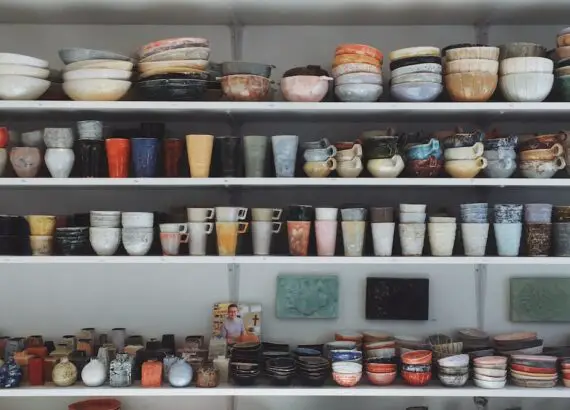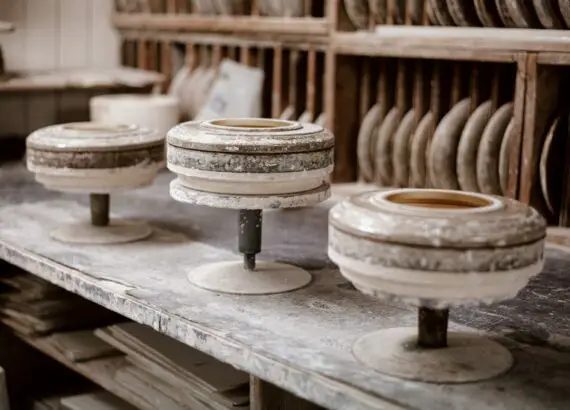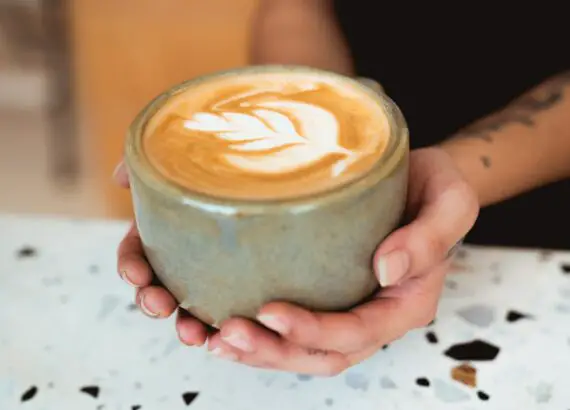16 Important Pottery Questions (Quick Answers)

Like many other things, pottery can be significantly damaged when it is mishandled. In other words, the quality, durability, and usability of pottery usually depend largely on the nature and amount of care it is given.
When it comes to pottery, a lot more goes into the process than just shaping and firing, and it can be not very clear. Here are 16 of the most asked questions by people about pottery care and storage.
Table of Contents
1. Why Pottery is Fun?
You communicate as a potter through your work. With your own hands, you can make gorgeous, sculptures and utilitarian items. This makes people pleased. According to studies, the creative process reduces cortisol, the stress hormone, as well as heart rate and blood pressure, while also increasing good feelings. In reality, handcrafting, sculpting, and wheel tossing may be quite soothing for both our physical and emotional well-being.
2. Why People Like Pottery?
It is a refreshing feeling when one can create something using their hands. This is what pottery offers. A sense of control and power. One which the potter uses in determining the outcome. Not only does this expression make us pleased, but it also enhances our self-esteem and gives us a sense of success. It’s worth noting that dealing with clay necessitates patience. Potters have accepted that the process cannot be rushed and that they must learn to work with the difficulties of the art.
3. Is Pottery the Same as Ceramics?
Yes, pottery is the same thing as ceramics. Ceramic is a term that is Greek in origin and it means ‘for pottery’ or ‘of pottery’. Pottery is a form of pottery that consists of clay-based vessels. So an artwork constructed of clay would be ceramics rather than pottery. Both pottery and ceramic are names that mean things made of clay, fired to harden them, and then decorated or glazed.
4. How Old is Pottery?
The earliest ceramic item discovered dates back to 28,000 BCE. Venus of Doln Vstonice is a figurine of a lady from a small historic village near Brno, Czech Republic. Near the ruins of a horseshoe-shaped kiln, hundreds of clay figurines portraying Ice Age animals were also discovered. There has been an earlier discovery in northern Jiangxi Province, in China. These pots dated back to 18000 BC out of the need for something to use for storage of things like water and grains. Sherds have been found in China and Japan from a period between 12,000 and perhaps as long as 18,000 years ago. This means that the oldest known record of pottery is about 18000 to 30000 years ago.
5. Is Pottery an Industrial Art?
Pottery is an industrial art because it majors in using the hand to get its desired results. This is an undeniable fact about industrial art. The practice to learn a skill arose from the inability of some persons to acquire formal education. Then, it was largely described as vocational training. Tools and manual application were the basic requirements to achieve the expected results. Without any intellectual ability, people still thrived in pottery.
6. What’s the Difference Between Sculpture and Pottery?
While clay constitutes the highest percentage of pottery components, sculpting can comprise several other features, including but not limited to clay.
1. Purpose
Sculpting has been used in both representative artwork (the imitation or modeling of various life forms) and non-representative artwork (used to embody or represent non-living things and inanimate objects like houses).
Pottery is majorly used for non-representative artwork like utilities, and the decorative pieces borne out of this branch of visual art are typically less durable and unable to withstand the barrage of time. Generally, pottery falls under the utilitarian aspect of art, while sculpture is an art and is usually non-functional.
2. Methods of creation
Sculpting, which is usually three-dimensional (possessing length, breadth, and width), was traditionally done by three methods:
- carving (fashioning artwork by removing unwanted pieces by use of a sharp tool),
- modeling (adding other substances or materials like clay, to the original material chosen to work with, e.g. stone, wood, bronze, bone, etc.), and, more recently,
- melding or using other unconventional materials (e.g. metal, paper, plastic, etc. to create various artwork.
Pottery is done strictly by molding and remolding clay into the desired shape and form, using the potter’s wheel or by hand. Although some potters carve out decorative aspects of some pottery, they cannot be entirely classified as sculptures, especially when they are utilitarian in function.
3. Materials
Used materials is perhaps the most obvious difference between sculpture and pottery. While pottery makes use of mostly clay (and some trace substances like silt, paper pulp, some precious metals, and other nonmetals for decorating), sculpting uses a variety of materials, all of which are determined by how unfettered the imagination of the artist is.
Some of the materials that have been used in famous sculptures include brass, bone, clay, metals, wood, gold, ivory, etc.
7. Why Is Pottery Important In Archaeology?
In the same way that studying prehistoric cave drawings has helped shed more light on how life was before civilization as we know it, pottery helps us understand to some extent, the different forms of artistic expressions people indulged in at the time.
Also, it helps archaeologists and scientists make calculated guesses at the social structures, type of economies, standard of living, political influences, etc. that existed in cultures before now.
8. Why Do Archaeologists Study Pottery?
As a general principle, archaeology aims to uncover the various dynamics that existed in past civilizations. One of the most durable and efficient ways of studying these dynamics is by studying pottery.
As the form and structure of pottery change with temperature, they become sturdier and more durable and less likely to be altered by decay or elements.
Findings from archaeology have proved overly helpful in drawing scientific and non-scientific deductions about prehistoric people and their cultures.
Food residues found in or on pottery have led scientists to paint pictures of social interactions, economic status, cultural and domestic dynamics that existed in time past.
9. How Should Pottery Be Stored?
Say you’ve just acquired some pottery pieces, and naturally, you want to show them off. Please resist the urge to place them in every corner of the house…
Not all pottery can withstand inevitable extreme temperature fluctuation (from hot to cold).
The best way to store pottery is to put them in places where the temperature is least likely to fluctuate. This preserves their durability and keeps them for longer. Place a lining under them to keep them from slipping. Also, remember to keep pottery away from direct sunlight.
10. Does Pottery Fade In The Sun?
Yes, pottery does fade in the sun. Unglazed pottery is the most vulnerable to fading when exposed to the sun due to the sun’s bleaching action on the surface of the pottery.
Aside from fading, the sun can cause the pottery’s moisture to evaporate quickly while pushing it to expand and crack. All factors considered, it is best to keep crockery shielded from the sun.
11. Can You Keep Your Pottery Outdoors?
While some pottery makes stunning decoration pieces, the fluctuating elements make it unwise to leave pottery pieces outdoors -especially terra cotta.
Ideally, pottery should be stored in a place where it is not exposed to extreme temperatures or humidity. They keep better indoors or in the dark and or areas with shade.
Planters are made of a tougher material than some ceramic and may be fine for a few days outside -away from direct sunlight.
12. Can Handmade Pottery Go In The Dishwasher?
While some potters think that their handmade pottery is dishwasher-safe, others are somewhat indifferent on the issue.
Homemade pottery (a) has brightly colored glazes or (b) has been fired at temperatures below 1,000 degrees F are least recommended for dishwasher use because they can be seriously damaged.
Other types of pottery that must not be put in dishwashers are sculptures (obviously), soft ceramic pottery, terra cotta, and different pottery types that weren’t air-dried before being fired (non-vitrified pottery).
13. Can You Bake Pottery In A Regular Oven?
Some types of pottery can be baked in a regular oven. Specifically, salt clay (a flour, oil, and salt mix) is the most malleable form of clay and can be baked in a regular oven.
Due to its low water content, Salt clay can be fired at temperatures compatible with a regular oven. However, this type of clay produces less durable pottery compared to pottery fired at high temperatures.
14. How Long Does Clay Pottery Last?
The longevity of clay pottery is mainly dependent on how it was handled and how much care it is given. Under the right conditions, clay pottery can last for thousands of years, and archaeology can prove it.
Glazed pottery typically lasts longer than unglazed pottery because they are vitrified.
When clay is fired, its structure is altered till it becomes similar to that of stone; any decomposition that follows would be identical to the decomposition of stone -slow and mainly due to abrasion.
15. Can You Put Handmade Pottery In The Microwave?
Pottery, especially ceramics, is typically microwave safe and non-toxic to food. Because pottery is fired at very high temperatures, they are more than able to stand the heat from a microwave.
The only exception to this principle is pottery with non-clay or non-glaze add-ons like metal, plastic, and so on. These add-ons may become too hot to handle, or they may melt.
16. How Do You Care For Handmade Pottery?
Taking proper care of store-bought pottery is as straightforward as the inscriptions that are written underneath.
On the other hand, handmade pottery can be a bit tricky as they come with their own set of rules.
For example, use soft brushes when washing, protect them from falls and rough-handling, soak them in diluted bleach if they’re new, and don’t subject them to opposite temperature extremes per time.



